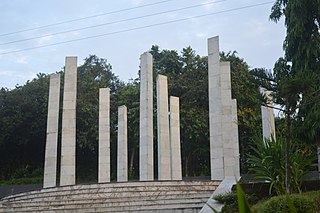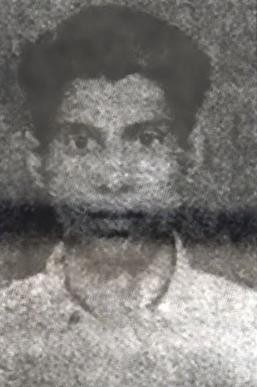Kamala Bhattacharya | |
|---|---|
 Kamala Bhattacharya | |
| Born | 1945 Sylhet, Assam, British India |
| Died | May 19, 1961 (aged 16) |
| Nationality | Indian |
Kamala Bhattacharya was an Indian student who was martyred in the Bengali Language Movement in Silchar in 1961.
Kamala Bhattacharya | |
|---|---|
 Kamala Bhattacharya | |
| Born | 1945 Sylhet, Assam, British India |
| Died | May 19, 1961 (aged 16) |
| Nationality | Indian |
Kamala Bhattacharya was an Indian student who was martyred in the Bengali Language Movement in Silchar in 1961.
Kamala was born to Ramraman Bhattacharya and Suprabasini Devi, the fifth of seven children in the year 1945 in the erstwhile Sylhet district in Assam. In their family they were three sons and four daughters. She was the third of the four daughters, having a younger sister and a younger brother. Their family had to struggle through many hardships, after she lost her father early in her childhood. During the Partition of India, the district of Sylhet was acceded to Pakistan on the basis of Sylhet referendum. In the 1950 East Pakistan genocide, hundreds of Hindus were killed in Sylhet and they migrated to India in large numbers. Kamala's mother too migrated to Silchar in the Cachar district in the year 1950. [1]
Kamala's family used to stay in a rented accommodation in Silchar Public School Road. Her eldest sister Benu took up a nursing job and went to Simaluguri for training. Kamala's elder sister Pratibha was a school teacher. Her family was economically dependent on her earning for their livelihood. In her childhood, Kamala attended the Chhotelal Seth Institute in Silchar. [2] She did not have the financial stability to buy the school text books. She had once asked her eldest sister Benu to buy her a dictionary for her, which her sister could not afford. She used to borrow books from her classmates and copy the text and read them. In 1961, Kamala appeared for the matriculation exams. She was determined to complete her graduation and had planned to learn typewriting before the matriculation results were declared. [1]
The very next day after the matriculation exams, a picketing was being organized in Silchar railway station demanding Bengali as the medium of education. On the morning of May 19, after taking bath Kamala wore the saree of her elder sister Pratibha and prepared to go to picketing. Her elder sister warned her of possible dangers. In the meanwhile, a group of 20-22 girls came to their house to take her. They alleviated her mother's concerns and took Kamala along with them. Kamala's mother gave her a piece of cloth to defend herself from tear gas. Kamala's younger sister Mangala, younger brother Bakul and her nephew Bappa too accompanied the group. Later during the day, Kamala's mother herself went to the railway station to enquire about their whereabouts. Bakul and Bappa had once been arrested by the police and then released. Kamala washed her mother's feet of the dust, gave her a sharbat and then sent her back home.
The rail blockade programme had passed off peacefully in the morning. In the afternoon, the Assam Rifles had begun to arrive at the railway station. At around 2-35 P.M. the paramilitary police started beating the protesters with rifle butts and batons without any provocation from them. Kamala's younger sister hit by the police, fell to the ground and began crying to Kamala for help. The police had opened fire on the protesters by then. As Kamala rushed to the rescue of her younger sister, a bullet pierced through her eye and hit her head. Kamala was taken to hospital along with other wounded and bullet hit protesters. She died in the hospital. Unconscious Mangala too was admitted to hospital, where she regained her consciousness after one month. She became mentally unstable for the rest of her life.
In 2011, Gopa Dutta Aich unveiled bronze bust of Kamala Bhattacharya in the premises of the Chhotelal Seth Institute under the aegis of Shahid Kamala Bhattacharya Murti Sthapan Committee. [3]

Cachardistrict is an administrative district in the state of Assam in India. After independence, the pre-existing undivided Cachar district was split into four districts: Dima Hasao, Hailakandi, Karimganj, and the current Cachar district. Silchar is Cachar district's center of government.

Karimganj district is one of the 31 districts of the Indian state of Assam. Karimganj town is both the administrative headquarters district and the biggest town of this district. It is located in southern Assam and borders Tripura and the Sylhet Division of Bangladesh. It makes up the Barak Valley alongside Hailakandi and Cachar. Karimganj was previously part of the Sylhet District before the Partition of India. It became a district in 1983.

Silchar is a city and the headquarters of the Cachar district of the state of Assam, India. It is second largest city of Assam after Guwahati in terms of area, population and GDP. It is also administrative capital of Barak Valley division. It is located 343 kilometres south east of Guwahati. It was founded by Captain Thomas Fisher in 1832 when he shifted the headquarters of Cachar to Janiganj in Silchar. It earned the moniker "Island of Peace" from Indira Gandhi, the then Prime Minister of India. Silchar is the site of the world's first polo club and the first competitive polo match. In 1985, an Air India flight from Kolkata to Silchar became the world's first all-women crew flight. Silchar was a tea town and Cachar club was the meeting point for tea planters.

The Barak Valley is the southernmost region and administrative division of the Indian state of Assam. It is named after the Barak river. The Barak valley consists of three administrative districts of Assam namely - Cachar, Karimganj, and Hailakandi. The main and largest city is Silchar, which seats the headquarter of Cachar district and also serves as administrative divisional office of Barak valley division. The valley is bordered by Mizoram and Tripura to the south, Bangladesh and Meghalaya to the west and Manipur to the east respectively. Once North Cachar Hills was a part of Cachar district which became a subdivision in 1951 and eventually a separate district. On 1 July 1983, Karimganj district was curved out from the eponymous subdivision of Cachar district. In 1989 the subdivision of Hailakandi was upgraded into Hailakandi district.

The Bengali Language Movement of Barak Valley was a protest against the decision of the Government of Assam to make Assamese the sole official language of the state, even though most of the Barak Valley residents spoke Bengali. About 80% of the Valley's residents are ethnic Bengalis. In the Barak Valley region, the ethnic Bengali population consists of both Hindus and Muslims, who are almost equal in population and constitute the overwhelming majority of the population. There is also a substantial minority of native tribes and immigrants from other parts of India. The main incident took place on 19 May 1961 at Silchar railway station in which 11 ethnic Bengalis were killed by the Assam police.

Moinul Hoque Choudhury was an Indian politician from Assam. A five-time MLA; he was the Minister of Commerce and Industrial Development during Indira Gandhi regime in 1971. He is also known as the Industrial Reformer of the Barak Valley.

Goynar Baksho is a 2013 Bengali-language Indian horror comedy film directed by Aparna Sen. The film is based on a novel Goynar Baksho and a short story Rashmonir Sonadana, both written by Shirshendu Mukhopadhyay and published in Desh magazine. The film premiered in Kolkata on 12 April 2013.

Sachindra Chandra Pal was an Indian student who took part in the Bengali Language Movement in Silchar. He was killed on 19 May 1961. Sachindra Paul Road in Silchar is named in his memory.

Kanailal Niyogi was an employee of the Indian Railways who took part in the Bengali Language Movement in the Barak Valley in 1961. On 19 May 1961, Niyogi became a martyr when he was shot dead by the paramilitary forces at the Tarapur railway station in Silchar.

The Sylheti or Sylhetis are an Indo-Aryan ethnocultural group that are associated with the Sylhet region. There are strong diasporic communities in Barak Valley of Assam, India, North Tripura, as well as in rest of Bangladesh and northeast India. They speak Sylheti, an Eastern Indo-Aryan language that is considered "a distinct language by many and a dialect of Bengali by some others".

Silchar railway station is a railway station situated at Tarapur, Silchar in Assam. The railway station falls under the jurisdiction of the Northeast Frontier Railway zone of the Indian Railways. The railway gauge functioned here is broad gauge. The station consists of single diesel line". It is one of the oldest railway station in India built under Assam Bengal Railway. The station has three platforms with a total of 14 originating trains. It serves Silchar, as well as the whole Barak Valley. Trains operate to different cities of India from Silchar including Delhi, Kolkata, Chennai, Visakhapatnam, Kanpur, Patna, Prayagraj, Hyderabad, Coimbatore, Vijayawada, Guwahati, Bhubaneswar, Thiruvananthapuram, Agartala & Dibrugarh. As of now, 170 stations across India are directly connected to Silchar railway station.
Jyotsna Chanda (1904–1971) was a politician, member of the Congress Party and a Parliamentarian who served as a member from Assam. She served in the Third and Fourth Lok Sabha, from 1962 to 1967 and 1967–1970, respectively.

Karunamoyee Rani Rashmoni was an Indian Bengali historical drama television series which aired on Bengali Entertainment Channel Zee Bangla and is also available on the digital platform ZEE5. It was premiered on 24 July 2017. The serial was earlier produced by Subrata Roy and then it was produced by Zee Bangla. It completed 1,000 episodes on its third birthday and 1,500 episodes on 26 December 2021. After a successful run of 4+1⁄2 years, Karunamoyee Rani Rashmoni went off-air on 13 February 2022.

Ekhane Akash Neel is a Bengali romantic medical drama series that aired on Star Jalsha and streamed on the digital platform Hotstar from 23 September 2019. It was a reboot of the popular show Ekhane Aakash Neel. It was also the remake of the StarPlus show Sanjivani. Produced by Surinder Films, it starred Sean Banerjee as Dr. Ujaan Chatterjee and Anamika Chakraborty as Dr. Hiya Chatterjee. It ended on 3 October 2020 and was replaced by Ogo Nirupoma.

Rimli was an Indian Bengali Language Drama television series which was broadcast on Bengali General Entertainment Channel Zee Bangla and was also available on the digital platform ZEE5 even before TV telecast. It starred Idhika Paul and John Bhattacharya in the lead roles. It was premiered on 15 February 2021. The series was produced by Acropoliis Entertainment. It was about a farming girl Rimli. The show went off air on 26 September 2021, due to low television ratings.

Amader Ei Poth Jodi Na Sesh Hoy is an Indian Bengali language Romantic Comedy Drama television series that broadcasting on Indian Bengali General Entertainment Channel Zee Bangla and is also available on the digital platform ZEE5. It premiered on 12 April 2021 and stars Annwesha Hazra and Writwik Mukherjee. The series is produced by Crazy Ideas Media.

The Bengali Hindus are the second-largest Hindu community just after Assamese Hindus in Assam. As per as estimation research, around 6–7.5 million Bengali Hindus live in Assam as of 2011, majority of whom live in Barak Valley and a significant population also resides in mainland Brahmaputra Valley. The Bengali Hindus are today mostly concentrated in the Barak Valley region, where they were historically a minority, and now are politically, economically and socially dominant. Assam hosts the second-largest Bengali Hindu population in India after West Bengal.
Anti-Bengali sentiment comprises negative attitudes and views on Bengalis. This sentiment is present in several parts of India: Gujarat, Bihar, Assam, and various tribal areas. etc. Issues include discrimiation in inhabitation, other forms of discrimination, political reasons, government actions, anti-Bangladeshi sentiment, etc. The discriminative condition of Bengalis can be traced from Khoirabari massacre, Nellie massacre, Silapathar massacre, North Kamrup massacre, Goreswar massacre, Bongal Kheda, etc. This has led to emergence of Bengali sub-nationalism in India as a form of protest and formation of many pro-Bengali organisations in India.
Zobeda Khanom Chowdhury, also known as Zobeda Rahim Chowdhury, was one among the leading woman who partook in the Bengali language movement from Sylhet and a pioneering women in Bangladeshi politics.
Moulvi Abdul Munim Choudhury was an Indian Bengali politician and Islamic scholar. He was the former two-time member of the Assam Legislative Assembly for the Karimganj South constituency.